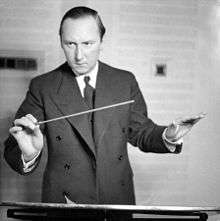Lars-Erik Larsson
Lars-Erik Larsson (15 May 1908 – 27 December 1986) was a Swedish composer.

Biography
Lars-Erik Vilner Larsson was born in Åkarp in 1908, the son of a factory worker and a nurse. He studied with Ellberg at the Stockholm Conservatory (1925–1929) and with Alban Berg and Fritz Reuter in Vienna and Leipzig (1929–1930), then worked for Swedish Radio and taught at the Stockholm Conservatory (1947–1959) and Uppsala University where he held the position as Director musices (1961–1966).
His style as a composer is eclectic, ranging from the late Romantic to techniques derived from Arnold Schoenberg's twelve-note system, but original in method. He was the first Swede to write serial music (1932). Yet other works of that period are post-Sibelian or neo-classical, and his output generally is characterized by variety of style.
He wrote for the theatre, cinema and broadcasting, in addition to the more traditional forms of symphony, concerto, chamber and vocal music.
He died of diabetes complications in Helsingborg in 1986, aged 78.
Works
Larsson wrote two of the most popular works in Swedish art music:
- Pastoral suite (Pastoralsvit), for chamber orchestra, Op. 19 (1938)
- A God in Disguise (Förklädd gud), a non-religious lyrical suite for mixed chorus, soloists and orchestra, Op. 24 (1940; text written by Malmö poet Hjalmar Gullberg)
Larsson's most important symphonic works are his three symphonies for full orchestra:
- Symphony No. 1 in D major, Op. 2 (1927–28)
- Symphony No. 2, Op. 17 (1936–37)
- Symphony No. 3 in C minor, Op. 34 (1944–45)
Other works for orchestra:
- A Winter's Tale (En Vintersaga), Op. 18 (1937–38)
Larsson also wrote a Sinfonietta for string orchestra and a popular Little Serenade for the same medium.
He wrote a series of 12 concertinos for solo instruments: flute, saxophone, clarinet, bassoon, oboe, horn, trumpet, trombone, violin, viola, cello, double bass and piano.
Larsson's Concerto for alto saxophone, written for Sigurd Raschèr in 1934, is one of the first major works for saxophone to utilize ideas of non-standard tonality.
The Violin Concerto, Op. 42 (1952) is another important work, as is the opera Prinsessan av Cypern.
Chronological worklist
- 1927 Op. 1, A Fiddler's Last Journey, ballad, bar orchestra
- 1927-8 Op. 2, Symphony No. 1 D major
- 1928 Op. 3, Violin Sonatina
- 1929 Op. 4, Concert Overture No. 1
- 1930 Op. 5, Symphonic Sketch
- 1931 Op. 6, Duo, violin viola
- 1931-2 Op. 7, Divertimento No. 1, chamber orchestra
- 1932? Op. 8, Ten piano pieces
- 1931-6 Op. 9, Prinsessan av Cypern (The Princess of Cyprus), opera
- 1932 Op. 10, Sinfonietta, str
- 1932 Op. 11, The Bright Country
- 1934 Op. 12, Little Serenade, str
- 1934 Op. 13, Concert Overture No. 2
- 1934 Op. 14, Saxophone Concerto, altsax str
- 1935 Op. 15, Divertimento No. 2, chamber orchestra
- 1936 Little March, orchestra
- 1936 Op. 16, Piano Sonatina No. 1
- 1937 Op. 17, Symphony No. 2
- 1937-8 Op. 18, A Winter's Tale, 4 movements, orchestra
- 1937-8 Op. 19, Hours of Day Suite, 6 movements incl Pastoral Suite, orchestra
- 1937-8 Op. 19, Pastoral Suite, 3 movements orchestra
- 1938 Op. 20, Intimate Miniatures, strqt
- 1938 Op. 21, Invocatio, for choir and orchestra
- 1939 Op. 22, Festmusik, orchestra
- 193? Twelve Folksongs: includes Watercolour; BoxPainter; HerbGirl, mezzo pno
- 1940 Op. 23, Jorden Sjunger, orchestra
- 1930–40 Op. 24, God in Disguise, lyric suite, sop bar narr orchestra
- 1940 Op. 25, Väktarsånger, for baritone, male choir and orchestra
- 1941 Op. 26, Röster Från Skansen, lyric suite for recitation,barytone,choir and orchestra
- 1941 Op. 27, The Swedish Nation, lyric suite, orchestra
- 1941 Op. 27a, Folksong Night, orchestra
- 1944 Op. 28, Kungajakt, film: Gustaviansk Suite, fl hpschd str
- 1944 Op. 29, Four songs
- 1944 Op. 30, Det Röda Korset, Cantata for recitation,barytone,choir and orchestra
- 1944 Op. 31, String Quartet No. 1 D minor
- 1944 Op. 32, Two Pieces, orchestra
- 1945 Op. 33, Two songs
- 1944-5 Op. 34, Symphony No. 3 C minor
- 1946 Op. 35, Nine Gullberg Songs
- 1946 Op. 36, Sankta Lucia, incidental music
- 1946-7 Op. 37, Cello Concerto
- 1946-7 Op. 38, Croquiser, pno
- 1947 Op. 39, Piano Sonatina No. 2
- 1948-9 Op. 40, Music for Orchestra
- 1950 Op. 41, Piano Sonatina No. 3
- 1952 Op. 42, Violin Concerto
- 1954 Op. 43, Missa Brevis
- 1955 Op. 44, String Quartet No. 2, Quartetto alla Serenata
- 1955 Op. 45/1, Flute Concertino, +str
- 1954-5 Op. 45/2, Oboe Concertino, +str
- 1956-7 Op. 45/3, Clarinet Concertino, +str
- 1955 Op. 45/4, Bassoon Concertino, +str
- 1954 Op. 45/5, Horn Concertino, +str
- 1953 Op. 45/6, Trumpet Concertino, +str
- 1955 Op. 45/7, Trombone Concertino, +str
- 1956 Op. 45/8, Violin Concertino, +str
- 1954-6 Op. 45/9, Viola Concertino, +str
- 1954-6 Op. 45/10, Cello Concertino, +str
- 1957 Op. 45/11, Double-Bass Concertino, +str
- 1957 Op. 45/12, Piano Concertino, +str
- 1957-8 Op. 46, Linden, ballet
- 1960 Op. 47, Twelve Little Pieces, pno
- 1960 Op. 48, Adagio, str
- 1960 Op. 49, Three Pieces, orchestra
- 1962 Op. 50, Variations for Orchestra
- 1964 Op. 51, Intrada Solemnis, for trumpets, trombones, doublechoir, boys choir and organ
- 1964? Op. 52, Eight songs
- 1966 Op. 53, Soluret Och Urnan, cantata for barytone, choir and orchestra
- 1966 Op. 54, Lyric Fantasy, orchestra
- 1968 Op. 55, Quattro Tempi, Divertimento, windquintet
- 1969 Op. 56, Easy Pieces, pno
- 1969 Op. 57, Five Pieces, pno
- 1969 Op. 58, Seven Little Fugues with Preludes, pno
- 1969? Op. 59, Tre citat, for choir
- 1969 Op. 60, Cello Sonatina
- 1970 Op. 61, Three Pieces, cl pno
- 1971 Op. 62, Due Auguri, orchestra
- 1972 Op. 63, Aubade, ob strtrio
- 1973 Op. 64, Raa Rokoko, orchestra
- 1975 Op. 65, String Quartet No. 3